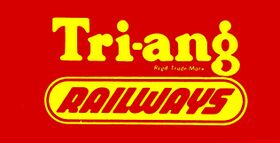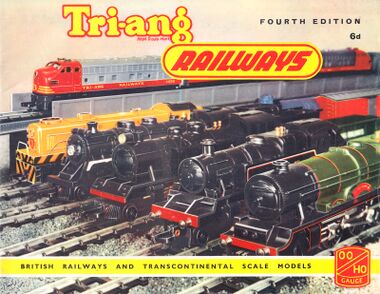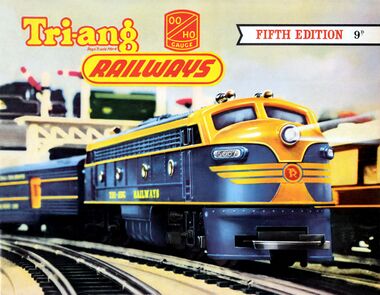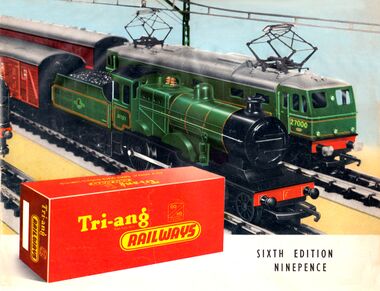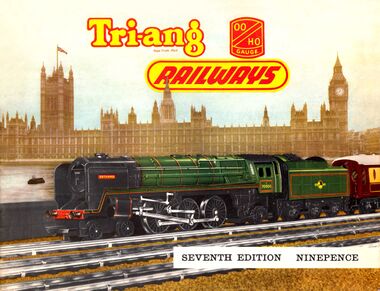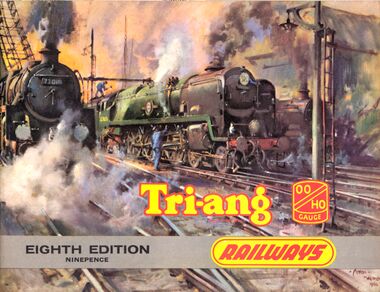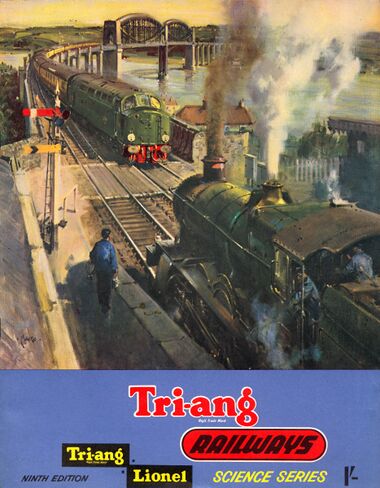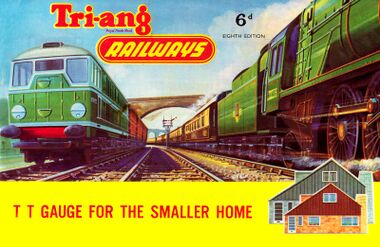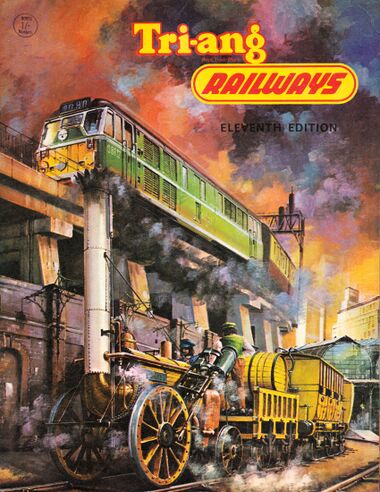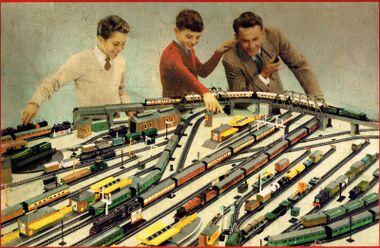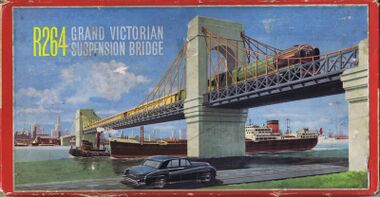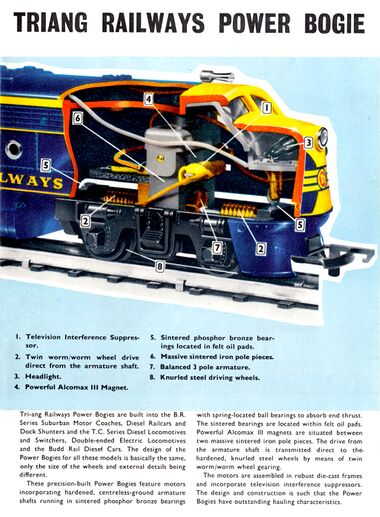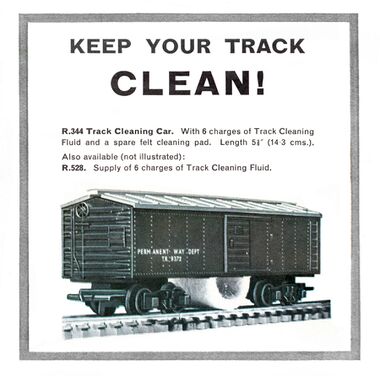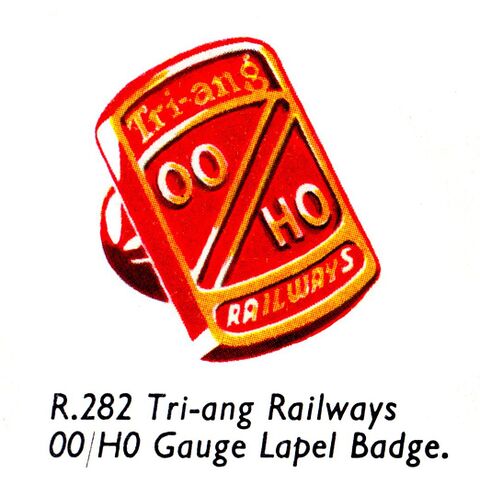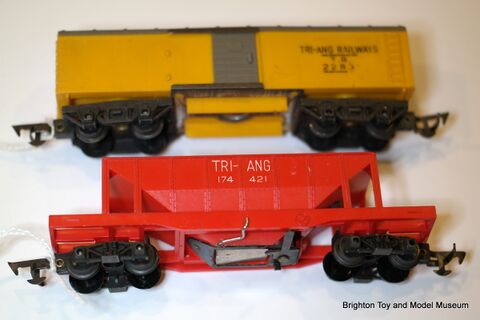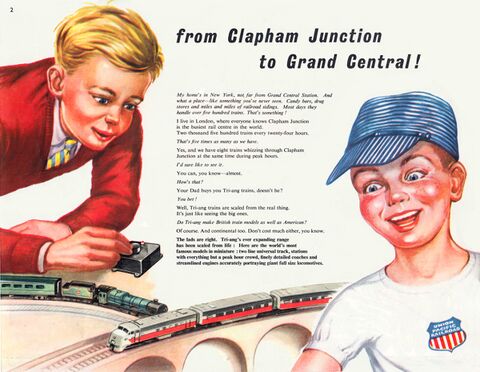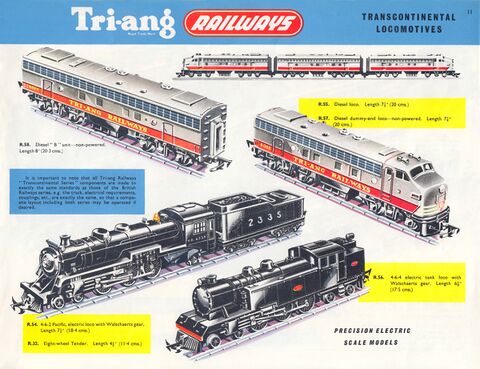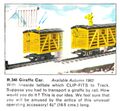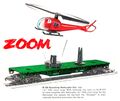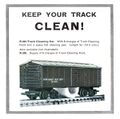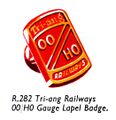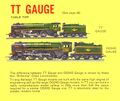Category:Tri-ang Railways
| Toy Brands and Manufacturers |
|---|
Tri-ang Railways |
| 1951 - 1964 |
1956: Second Edition of the Tri-ang Railways catalogue (16 pages) [image info]
1957: Third Edition of the Tri-ang Railways catalogue [image info]
1958: Fourth Edition of the catalogue [image info]
1959: Fifth Edition of the Tri-ang Railways catalogue [image info]
1960: Sixth Edition of the Tri-ang Railways catalogue [image info]
1961: Seventh Edition of the Tri-ang Railways catalogue [image info]
1962: Eighth Edition of the Tri-ang Railways catalogue [image info]
1963: Ninth Edition, with Tri-ang Lionel Science Series [image info]
1964: TT gauge catalogue [image info]
1964: Tenth Edition of the Tri-ang Railways catalogue [image info]
1965: Eleventh Edition of the Tri-ang Railways catalogue. This was the final Tri-ang Railways catalogue, later the same year the company put out a brochure announcing that the range was being merged with that of Hornby Dublo, to create Tri-ang Hornby [image info]
RS5 box photo [image info]
R.264 Grand Victorian Railway Bridge [image info]
1960: Triang Railways power bogie cutaway diagram [image info]
1962: Track cleaning car [image info]
The Triang Railways brandname was used by Lines Brothers for the model railway sets and components produced for them by Rovex Plastics after they'd bought the company and relocated it to Margate.
The brandname lasted until Lines Brothers bought the failing Meccano Ltd. in 1964, after which Lines Brothers renamed it Tri-ang Hornby.
Background
The UK mass-market for 00-gauge model railways had been created in the mid-to-late 1930s by Bassett-Lowke and Trix with the Twix Twin Railway system (TTR), a slightly clunky trail-blazer product that was deigned by the people who'd produced Bing Table Railway in the Mid-1920s, and by Meccano Ltd with their more finely engineered Hornby Dublo range almost immediately afterwards.
Both of these ranges were engineered by designers who were used to working in metal, with TTR designed to stay on the track through sheer weight and oversized wheels, and with the similarly weighty Dublo system designed to be the "Rolls Royce" of 00-gauge.
Trix focused on engineering solidity to the point of clunkiness, and Dublo products were engineered, as the advertising materials proclaimed, "To last a lifetime".
Neither company was all that worried about how much their heavy metal trains cost to produce, as both companies had been selling larger and more expensive systems - Bassett-Lowke had sold some very expensive ranges of larger model railways from gauge 1 right up to garden railways, and Meccano had been producing gauge 0 systems (Hornby Series) that, while still pretty expensive, where cheap compared to the B-L product range.
With 00-gauge model railways whipping up interest in the hobby, Rovex Plastics arrived on the scene looking for some sort of product to make with their moulding machines, and after being commissioned to produce a cheap model railway for a high street chain, were bought by the UK toymaking giants Lines Brothers and installed in a new factory in Margate, where they benefited from their parent company's engineering and marketing experience (in almost every sector but plastics), and started cranking out lightweight and affordable train sets aimed at the masses, under the brandname Tri-ang Railways.
North American outlines
With Hornby Dublo and Trix TTR both highly focused on producing ranges of specifically British trains, Tri-ang Railways decided to branch out a little more and produce models of British and North American trains, the idea presumably being that the American loco outlines would represent a "niche" where they wouldn't have to compete with Dublo and TTR. Early catalogues emphasised the transatlantic reach of the range, and since the American markets tended to use the fractionally smaller scaling of H0 rather than 00 (on the same track), which was made easier by the fact that so many of the North American locos were so much larger in real life, Triang Railways referred to their main range as being "00/H0", and tended to avoid mentioning the exact scaling used for the models.
Another factor encouraging the company to produce North American-style locos and rolling stock was that Lines Brothers had a Canadian subsidiary Thistle, which used the "Thistle" trademark (based on G and J Lines' original logo). In order for Tri-ang to continue their "push" in Canada, they had to have trains in their range that looked something like the sorts of trains that Canadian children were used to seeing in real life
Novelties
Another Tri-ang Railways "niche" was "novelty" rolling-stock – a range of "gimmick" wagons that carried searchlights or rocket launchers, an extreme example of which was the "Giraffe Wagon", a circus wagon with a giraffe's head poking out of a hatch in the roof, that would be triggered to make the giraffe "duck" whenever the wagon was about to go under a bridge. Although some of these were technically quite advanced and presumably enthralled many small children, (for instance the "helicopter wagon" with a spring in the base that could spin up its copter's blade and launch it into the air when triggered), this didn't endear the range to more "serious" model railway enthusiasts who were concerned with authenticity.
Triang Railways TT
Tri-ang's "TT" or "tabletop" range (presented in 1957) was aimed at potential buyers who wanted a model railway system that was optimised for convenience. Tri-ang's TT pieces were around three-quarters of the size of their 00/HO model railways (3mm to the foot, or approximately 1/100-scale), which was considered to be the best compromise that allowed a noticeably smaller size (and lower cost), while still allowing a decent level of detailing. While hardcore enthusiasts would still probably go for H0/00, and not mind dedicating a significant amount of space to their layouts, TT was designed for people who had less space ("TT Gauge for the smaller home"), or who were less prepared to set aside large areas for a model railway.
The system was small, and neat, and still has a healthy following today.
General Specification
STANDARDS:
Track gauge is 12mm (approx 15/32 ") Rolling stock is built to a scale of 3mm. to the foot.
PACKING:
Al TT gauge sets and accessories are packed in yellow cartons with red lettering.
FINISH:
Bodywork throughout the range is impact Polystyrene ensuring great accuracy of detail combined with correct colouring and remarkable strength.
ELECTRICITY SUPPLY:
The locomotives are designed to operate from a supply of 12 volts Direct Current. This supply can be derived form Alternating Cutrrent Mains using a suitable Transformer Rectifier, Dry Batteries or an accumulator.
TRACK:
Each Train Set is supplied with track to form an oval 25" × 34" and includes a remote control spring operated uncoupling track section.
ACCESSORIES:
Additional accessories will be introduced continually to enable a comprehensive layout to be built.
SERVICING:
The simplicity of the mechanisms is such that a minimum of maintenance will be required. Full Tri-Ang Railways Service facilities are, however, available together with a complete range of spare parts.
— preview leaflet, circa ~1957, -
After Tri-ang Railways
After the 1964 buyout of Meccano Ltd, the merged Hornby and Triang ranges were nominally "Tri-ang Hornby", but were in practice mostly Tri-ang designs, once the existing Dublo stocks had been sold off or passed to G&R Wrenn. However,the Dublo range did leave a strong legacy on the new Triang range in that in "inheriting" the Hornby customer-base the company did, to a great extent, have to try to pull the range up to a level of UK railway-enthusiast authenticity that would be more likely to be approved of by a Dublo fan.
External links
Subcategories
This category has the following 8 subcategories, out of 8 total.
Pages in category ‘Tri-ang Railways’
The following 3 pages are in this category, out of 3 total.
Media in category ‘Tri-ang Railways’
The following 67 files are in this category, out of 67 total.
- Ambulance Car R248, Triang Railways (TRCat 1965).jpg 2,907 × 1,815; 572 KB
- Blue Pullman Diesel Motor Cars, powered and unpowered, R-555 and R-556 (TR 1963).jpg 3,000 × 1,166; 1.58 MB
- Blue Pullman Train Set, Tri-ang RS-52 (TR 1964).jpg 4,592 × 1,431; 2.79 MB
- Bomb Transporter R239, Triang Railways (TRCat 1963).jpg 1,600 × 729; 193 KB
- British Locomotives, Triang Railways (TRCat 1956).jpg 1,600 × 1,237; 623 KB
- CKD Completely Knocked Down kits, Triang Railways (TRCat 1963).jpg 1,705 × 2,200; 869 KB
- Exploding Car R249, Triang Railways (TRCat 1963).jpg 1,600 × 1,040; 319 KB
- Four-Rocket Launcher R343, Triang Railways (TRCat 1963).jpg 1,600 × 1,079; 287 KB
- Freight wagon 22831, yellow (Triang Railways R.114).JPG 1,200 × 800; 436 KB
- Gamages Special Electric Train Set (Gamages 1961).jpg 2,200 × 1,357; 604 KB
- Gamages special value train sets (Gamages 1959).jpg 2,000 × 1,244; 622 KB
- Giraffe Car R348, Triang Railways (TRCat 1963).jpg 1,600 × 1,478; 337 KB
- Helicopter Car R128, Triang Railways (TRCat 1963).jpg 1,600 × 1,350; 293 KB
- Hopper Wagon 174421, red (Triang Railways R.111).jpg 1,200 × 800; 378 KB
- Locomotive mechanisms (TRCat 1958).jpg 1,600 × 416; 197 KB
- Luxury on the Line, Blue Pullman Train Set (TriangMag 1965-04).jpg 2,352 × 3,000; 2.23 MB
- Mary First Class Pullman carriage, Tri-ang Railways R-228 (TRCat 3rd 1957).jpg 2,000 × 1,219; 1.13 MB
- Monster Double Train Set RS47, Triang Railways (TRCat 1963)-005.jpg 1,942 × 2,500; 1.31 MB
- Railway Goods Shed, Minic Motorways M1808 (TriangRailways 1964).jpg 1,600 × 781; 566 KB
- Railway-Motorway Level Crossing, ungated, Minic Motorways M901 (TriangRailways 1964).jpg 1,600 × 1,196; 627 KB
- Road-Rail Buffer Stop, Minic Motorways RM913 (TriangRailways 1964).jpg 1,188 × 585; 208 KB
- Road-Rail Buffer Stop, Minic Motorways RM914 (TriangRailways 1964).jpg 1,218 × 583; 210 KB
- Road-Rail Junction, Type A, Minic Motorways RM911 (TriangRailways 1964).jpg 1,118 × 764; 343 KB
- Road-Rail Junction, Type B, Minic Motorways RM912 (TriangRailways 1964).jpg 1,152 × 764; 299 KB
- Road-Rail Track, Straight 6in, Minic Motorways RM910 (TriangRailways 1964).jpg 1,227 × 764; 331 KB
- Southern Electric locos, Tri-ang Railways (TRCat 1958).jpg 1,600 × 1,232; 562 KB
- Station and Lineside Buildings, Triang Railways (TRCat 1958).jpg 1,600 × 1,224; 576 KB
- Stephensons Rocket R346, Triang Railways (TRCat 1965).jpg 2,000 × 1,301; 460 KB
- Stephensons Rocket, Triang Railways (TRCat 1963).jpg 2,500 × 1,653; 1,004 KB
- The Blue Pullman, train set, box lid (Tri-ang Railways RS52).jpg 3,000 × 2,170; 5.79 MB
- The Tri-ang Railways factory at Margate (TRCat 1958).jpg 1,600 × 1,204; 450 KB
- Track Cleaning Car R344, Triang Railways (TRCat 1962).jpg 1,200 × 1,187; 237 KB
- Transcontinental Locomotives, Triang Railways (TRCat 1956).jpg 1,600 × 1,229; 584 KB
- Transcontinental Passenger and Freight Cars, 1of2, Triang Railways (TRCat 1956).jpg 1,600 × 1,221; 559 KB
- Transcontinental Passenger and Freight Cars, 2of2, Triang Railways (TRCat 1956).jpg 1,600 × 1,208; 539 KB
- Tri-ang Hornby catalogue, front cover (May 1965).jpg 928 × 1,200; 741 KB
- Tri-ang Hornby Convertors (RM 1965-10).jpg 1,605 × 2,102; 388 KB
- Tri-ang Railways lapel badge (TRCat 1958).jpg 1,044 × 1,077; 192 KB
- Tri-ang Railways R264 Grand Victorian Suspension Bridge box.jpg 1,600 × 830; 281 KB
- Tri-ang Railways, Minic Motorways, Arkitex, and Model-Land, integrated (TRCat 1965).jpg 2,324 × 3,000; 1.55 MB
- Triang Hornby Convertor Track R476 (THMCat 1965).jpg 2,400 × 1,471; 412 KB
- Triang Hornby Convertor Wagon R577 (THMCat 1965).jpg 2,500 × 1,493; 547 KB
- Triang Railways and Hornby Dublo, combined layout, Triang Hornby (THMCat 1965).jpg 3,500 × 2,348; 2.38 MB
- Triang Railways box logo.jpg 1,024 × 297; 43 KB
- Triang Railways logo (TRCat 1965).jpg 1,263 × 643; 111 KB
- Triang Railways Novelty Wagons (TRCat 1963).jpg 3,000 × 1,939; 1.52 MB
- Triang Railways Power Bogie (TRCat 1960).jpg 1,322 × 1,800; 584 KB
- Triang Railways RM-B Combination Railways Motorways Set (TRCat 1963).jpg 2,338 × 3,000; 1.7 MB
- Triang Railways RS5 box photo.jpg 1,600 × 1,045; 357 KB
- Triang Railways team up with Minic Motorways (TRCat 1963).jpg 2,314 × 3,000; 2.07 MB
- Triang Railways TT catalogue, front cover (TRTTCat 1964).jpg 1,600 × 1,042; 577 KB
- Triang Railways, 1957 catalogue front cover, third edition (TRCat 1957).jpg 2,200 × 1,697; 567 KB
- Triang Railways, 1959 catalogue front cover, fifth edition (TRCat 1959).jpg 2,200 × 1,706; 938 KB
- Triang Railways, 1960 catalogue front cover, sixth edition (TRCat 1960).jpg 2,200 × 1,685; 935 KB
- Triang Railways, 1961 catalogue front cover, seventh edition (TRCat 1961).jpg 2,200 × 1,686; 979 KB
- Triang Railways, 1962 catalogue front cover, eighth edition (TRCat 1962).jpg 2,200 × 1,690; 976 KB
- Triang Railways, 1965 catalogue front cover, eleventh edition (TRCat 1965).jpg 1,699 × 2,200; 4.05 MB
- Triang Railways, catalogue front cover (TRCat 1956).jpg 1,600 × 1,231; 582 KB
- Triang Railways, catalogue front cover (TRCat 1958).jpg 1,600 × 1,236; 1.64 MB
- Triang Railways, catalogue front cover (TRCat 1963).jpg 1,868 × 2,400; 1.53 MB
- Triang Railways, catalogue front cover (TRCat 1964).jpg 2,324 × 3,000; 4.89 MB
- Triang Railways, UK and US ranges (TRCat 1956).jpg 1,600 × 1,239; 443 KB
- TT gauge and 00 gauge compared, Triang Railways (TRCat 1963).jpg 1,600 × 1,343; 433 KB
